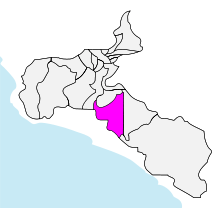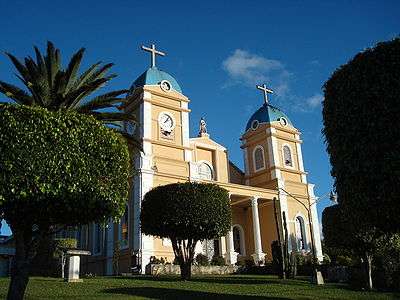Tarrazú (canton)
Tarrazú is the 5th canton in the province of San José in Costa Rica. The canton covers an area of 297.50 square kilometres (73,510 acres),[1] and has a population of 17,233. [2] The capital city of the canton is San Marcos. It is part of Los Santos Zone, together with Dota and León Cortés Castro.

The Río Pirrís (also known as Río Parrita) establishes much of the northern boundary of the three-pronged canton, which reaches south across the Coastal Mountain Range to its border with the canton of Aguirre in Puntarenas Province.
Districts
The canton of Tarrazú is subdivided into three districts (distritos):[3]
- San Marcos
- San Lorenzo
- San Carlos
History
The canton was established by a legislative decree of August 7, 1868. It was part of the Desamparados canton by that time.

Geography
Tarrazu is located about 70 kilometers south of the Capital San Jose, in a pristine valley surrounded by mountains that are part of the Talamanca Sierra in southern Costa Rica. Downtown San Marcos is 1350 meters above sea level but is surrounded by peaks as high as 3000 meters above sea level.
Economy
Highland coffee is the main source of income of local people. However, tourism and avocado production are of increased importance. During the months of December, January and February, population increases three-fold due to harvest time. San Marcos, the biggest town in the region, has become the center of economic activity. More recently the Costa Rican Institute of Electricity has invested millions of dollars in the Pirris Hydro Dam, scheduled to start generating energy by March 2011. The Hydro Dam is now the highest structure of its kind in Central America and will be key to the economic development of the region, not only in the highlands but the coastal regions of Quepos and Parrita. The region is deeply dependent on remittances from emigres who live in the United States, namely New Jersey. Few households in the region do not have a family member who lives and works in the United States. Ironically, this outmigration has led to an influx of thousands of Panamanian laborers to help realize the annual coffee harvest.[4] Tarrazu, particularly the San Lorenzo area, is felt to produce the most desirable coffee in Costa Rica.[5] Finca Palmilera coffee is grown here.[6] In November 2012, it was the most expensive coffee sold in Starbucks coffee shops in the United States.[7][8]
References
- Instituto Geográfico Nacional (IGN), 2001.
- Estimates of Instituto Nacional de Estadística y Censos (INEC), May 2003.
- "División Territorial Administrativa de Costa Rica" (PDF) (in Spanish). Instituto de Fomento y Asesoria Municipal (IFAM). 5 May 2009. Archived from the original (PDF) on 2 August 2015.
- Kordick, Carmen. The Saints of Progress: Coffee, Migration, and Costa Rican National Identity. University of Alabama Press, 2019.
- Elizabeth Barham, Bertil Sylvander (24 Jun 2011). Labels of Origin for Food: Local Development, Global Recognition. CABI. p. 146. Retrieved 7 July 2012.
- Costa Rica Finca Palmilera Roy Street Coffee and Tea, 2012-11-16.
- Starbucks' new super-expensive coffee: Geisha variety that sells for $7-a-cup Daily Mail, 2012-11-27.
- $7 Cup of Starbucks: A Logical Extension of the Coffee Chain’s Long-Term Strategy TIME 2012-11-30